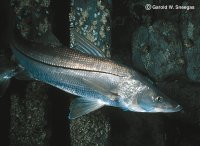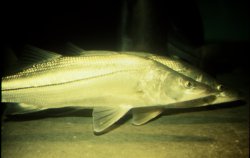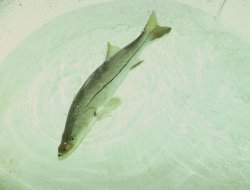Demystifying Snook
Randy Blankinship, Lower Laguna Madre Ecosystem Leader
Coastal Fisheries Division, 95 Fish Hatchery Road, Brownsville, TX 78520
Have you ever caught a snook? Have you ever even seen a snook? If you saw one, did you know what you were looking at the first time you saw it?
The legendary snook maintains a certain mystique in Texas due mainly to a history of abundance (prior to the 1940s) and its more recent unavailability to most anglers except those fishing bays, estuaries and nearshore Gulf of Mexico waters in South Texas. Even to most South Texas anglers, the snook remains a rare catch albeit an exciting one. It is also intriguing because of the size it attains: the current state record is 57.2 lbs caught in 1937 on the Gulf beach off Padre Island.

Snook are found in Texas bays, passes, streams, rivers and along Gulf beaches. Adult snook frequent shallow grass flats when water temperatures are warm, but may be found in deeper waters -- especially around structure such as pilings -- at all water temperatures. Peak spawning occurs from August through October in and around Gulf passes and the mouths of rivers that flow directly to the Gulf. Juvenile snook utilize estuarine habitat in the mouths of streams and rivers during their first year of life and are dependent on reliable freshwater inflows to maintain food availability and vegetation types needed for cover.
From the late 1800s to the early 1940s, commercial snook landings were quite large and even reached 230,000 lbs landed in Port Isabel in 1928. Since the early 1940s, commercial landings dropped to token levels with no landings reported after 1961. In 1987, regulations were passed that limited the catch of snook to rod and reel only.

Several reasons have been suggested for the decline of snook that involve range limitations due to cold temperature, high pesticide levels, disease, overfishing, and reduced freshwater inflows to bays and estuaries; however, the actual reason for the demise remains unknown. Recreational landings of snook remain relatively small at <0.1% of coastwide landings for all species. However, an encouraging recent trend in TPWD gill net samples conducted in the Lower Laguna Madre has shown a small increase in catch rates for snook in the 1990s through 2004 when compared to the 1970s and 80s.
The fish we in Texas call snook is actually made of at least 2 species and possibly 3. The species that attains sizes large enough to be legally kept (24–28 inches total length) is the common snook, Centropomus undecimalis. The two smaller species that have been identified, both called fat snook, C. mexicanus and C. parallelus, rarely grow to 24 inches in length. Work is currently underway to clarify the presence of the two fat snook species.

An interesting aspect of snook life history is that individual fish change sex from male to female. For common snook in Texas, this usually occurs between 30–34 inches total length. Because of this unique characteristic and low relative abundance, a bag limit of 1 snook per person per day was adopted in 1995. The combined strategy of size and bag limits is to reduce fishing mortality for male snook allowing more of them to achieve a larger size and change sex thereby increasing reproduction.
Fishery independent sampling programs conducted by TPWD show that current fishery management strategies are having a positive effect. Vigilance by sport anglers is needed, however, to maintain and protect important habitat for adult and juvenile snook. Shoreline habitat such as black mangrove, healthy seagrass beds and the availability of estuarine habitat in the mouths of rivers flowing to the Gulf (such as the Rio Grande) are all needed for healthy snook populations. While abundance levels of the first half of the 1900’s may not be seen again, relatively small population increases noticed recently do enhance the possibility of catching this elusive fish and help to maintain the lore and mystique of snook in Texas.
Current Snook Regulations
All Snook Species:
Minimum Length 24 inches
Maximum Length 28 inches
Bag Limit 1fish per person per day
© Copyright Texas Parks and Wildlife Department. No part of this work may be copied, reproduced, or translated in any form or medium without the prior written consent of Texas Parks Wildlife Department except where specifically noted. If you want to use these articles, see Site Policies